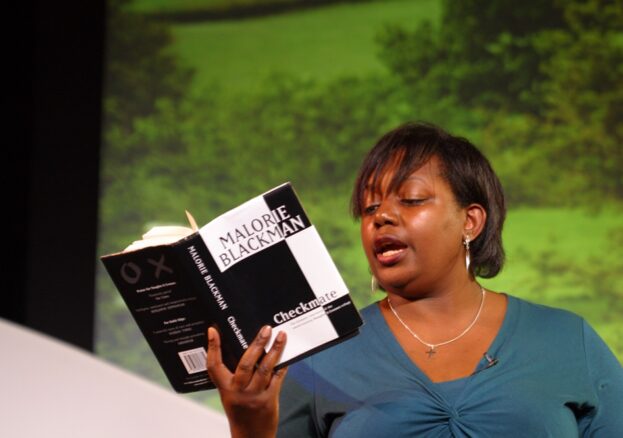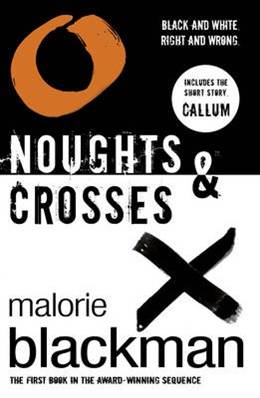
When Noughts & Crosses was published in 2001, it wasn’t just another young adult novel—it was a powerful act of reclamation. Malorie Blackman subverted the traditional narratives of dystopian fiction by inverting racial dynamics and centring Black characters in positions of power. Through this bold move, Blackman redefined the genre and reclaimed space for marginalised voices, creating a story that resonated deeply with readers from all backgrounds. This wasn’t just a story of love and resistance; it was a challenge to the way we understand power, identity, and systemic oppression.
For decades, Black characters in literature—especially in speculative fiction—had either been relegated to the margins or portrayed in stereotypical roles. Blackman recognised this void from her own childhood, growing up with few stories that reflected her experiences as a Black British girl. In Noughts & Crosses, she did more than just insert Black characters into the narrative; she positioned them at the centre of a society turned upside down, where Black people, known as Crosses, held power, while white people, the Noughts, were the oppressed.
By flipping the power dynamics in this way, Blackman reclaims space for Black voices in a genre where they had historically been excluded. She challenges the literary status quo and creates a world where Black readers can see themselves reflected in all their complexity—not just as characters, but as the powerful protagonists of their own stories.
For young Black readers, this was transformative. Noughts & Crosses gave them something rare in mainstream fiction: a narrative that reflected their struggles, their hopes, and their humanity. Blackman’s characters are not merely symbols of oppression or victimhood; they are dynamic individuals who navigate a world that seeks to define them by the colour of their skin. Through them, Blackman reclaimed the narrative for those who had been silenced or marginalised, making their stories visible and central to the plot.
Reimagining Power Dynamics
At the core of Noughts & Crosses is an exploration of power—who wields it, who is denied it, and how it shapes relationships and society as a whole. In Blackman’s dystopian world, the racial hierarchy is reversed: the Crosses hold the political, economic, and social power, while the Noughts are subjected to systemic oppression. This inversion serves as a radical critique of real-world racial power structures, inviting readers to re-examine the systems of inequality that govern their own societies.
The relationship between Sephy Hadley, a Cross, and Callum McGregor, a Nought, becomes a microcosm of this societal tension. Their love, forbidden by the rules of their world, symbolises the human desire to transcend divisions imposed by prejudice and power. But Blackman doesn’t offer easy resolutions. She shows us that love alone cannot dismantle deeply entrenched systems of oppression; instead, it becomes a form of resistance against the structures that seek to control and limit them.
This reimagining of power is central to Blackman’s reclamation of narrative space. By flipping racial hierarchies, she exposes the constructed nature of these divisions and challenges the idea that power is inherently tied to race. In doing so, she asks readers—particularly white readers—to confront the discomfort of seeing their own positions reversed. For Black readers, it offers a vision of a world where they hold power, but Blackman does not shy away from the complexities and responsibilities that come with it.
Amplifying Marginalised Voices
One of Blackman’s greatest achievements with Noughts & Crosses is her ability to amplify the voices of those who are often silenced in mainstream narratives. Through the experiences of the Noughts, who are denied access to quality education, meaningful employment, and basic human rights, Blackman mirrors the real-world struggles faced by marginalised communities. Her depiction of the Noughts as victims of systemic racism and media stereotyping serves as a powerful commentary on how Black and brown people are treated in contemporary society.
By centring her narrative on the experiences of the oppressed, Blackman gives voice to the voiceless. She refuses to allow these characters to be reduced to mere victims of circumstance. Instead, they are complex, resilient individuals who resist the dehumanising forces that seek to control them. Sephy, Callum, and their families are not defined solely by their oppression; they are defined by their agency, their choices, and their determination to fight for a better world.
In amplifying these voices, Blackman challenges her readers to engage with the lived realities of racism and inequality. She forces us to confront the impact of systemic discrimination, not as an abstract concept, but as a daily reality for millions of people. This reclamation of narrative is not just about representation; it’s about shifting the lens through which we view power, justice, and human dignity.
Reclaiming Dystopian Fiction
While dystopian fiction has long been a genre used to critique societal structures, Blackman’s approach in Noughts & Crosses reclaims dystopia by grounding it in real-world issues. Her world is not a distant, futuristic landscape; it is disturbingly close to our own, reflecting the existing structures of racism, segregation, and economic inequality. By rooting her dystopia in the realities of systemic racism, Blackman forces us to see the parallels between her fictional world and the world we live in today.
Through this lens, Blackman reclaims dystopian fiction as a tool for social critique that goes beyond speculative futures and directly addresses contemporary struggles. She challenges the genre’s tendency to universalise oppression, instead focusing on the specific ways in which race, power, and privilege intersect. In her hands, dystopia becomes a mirror, reflecting the injustices of the present while asking us to imagine a future that is not defined by the mistakes of the past.
What makes Blackman’s work so powerful is her refusal to offer easy answers or simplistic solutions. Noughts & Crosses does not present a utopian vision where racism is magically eradicated; instead, it shows us the complexities of fighting for justice in a world that is deeply divided by race and class. Through her characters, Blackman offers hope, but it is a hope tempered by the realities of struggle, sacrifice, and resistance.
Reclaiming Narratives and Redefining Fiction

Malorie Blackman
Malorie Blackman’s Noughts & Crosses is a masterclass in reclaiming narratives. By centring Black voices and inverting power dynamics, she reclaims space for marginalised stories within a genre that has often excluded them. Her work challenges readers to reconsider their perceptions of race, power, and privilege while amplifying the voices of those who have been silenced by mainstream narratives.
But Blackman’s reclamation of narrative goes beyond representation. It is a form of resistance against the dominant structures that have shaped our understanding of race and identity for so long. By reclaiming the right to define who holds power and whose stories matter, Blackman has redefined what dystopian fiction can be. Her work paves the way for future generations of writers and readers to continue the work of reclaiming and reshaping the stories that define our world.
